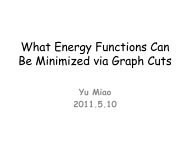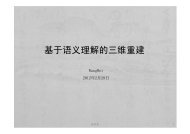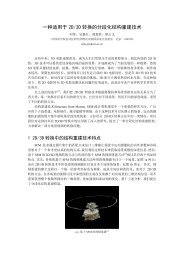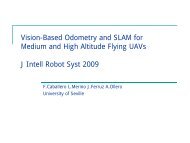Rotationally Invariant Descriptors using Intensity Order ... - IEEE Xplore
Rotationally Invariant Descriptors using Intensity Order ... - IEEE Xplore
Rotationally Invariant Descriptors using Intensity Order ... - IEEE Xplore
You also want an ePaper? Increase the reach of your titles
YUMPU automatically turns print PDFs into web optimized ePapers that Google loves.
This article has been accepted for publication in a future issue of this journal, but has not been fully edited. Content may change prior to final publication.<br />
<strong>IEEE</strong> TRANSACTION ON PATTERN ANALYSIS AND MACHINE INTELLIGENCE 19<br />
MROGH<br />
MRRID<br />
TABLE I<br />
PARAMETERS OF OUR PROPOSED DESCRIPTORS<br />
denotation parameter settings description<br />
k 4,6,8 number of spatial partitions<br />
d 4,8 number of orientation bins<br />
N 1,2,3,4 number of support regions<br />
k 4,6,8 number of spatial partitions<br />
m 3,4 number of binary codes<br />
N 1,2,3,4 number of support regions<br />
neighbor distance ratio [22]. In the remaining experiments, we used the same definitions of a<br />
match, a correct match and a correspondence.<br />
It can be seen from Fig. 9 that the performances of MROGH and MRRID are improved when<br />
the number of support regions is increased. When a single support region is used, MROGH<br />
performs the best with the parameter setting of ’d=8,k=8’, closely followed by the setting of<br />
’d=8,k=6’. While MRRID performs the best with the parameter setting of ’m=4,k=8’, followed by<br />
the setting of ’m=4,k=4’. Taking into consideration of performance and complexity (dimension),<br />
we use the parameter setting of ’d=8,k=6,N=4’ for MROGH and ’m=4,k=4,N=4’ for MRRID in<br />
the remaining experiments. Thus the dimensionality is 192 for MROGH and 256 for MRRID.<br />
recall<br />
1<br />
0.8<br />
0.6<br />
d=4,k=4,N=1(16)<br />
0.4<br />
d=4,k=6,N=1(24)<br />
d=4,k=8,N=1(32)<br />
0.2<br />
d=8,k=4,N=1(32)<br />
d=8,k=6,N=1(48)<br />
d=8,k=8,N=1(64)<br />
0<br />
0 0.1 0.2 0.3 0.4<br />
1−precision<br />
0.5 0.6<br />
recall<br />
1<br />
0.8<br />
0.6<br />
0.4<br />
0.2<br />
d=8,k=6,N=1(48)<br />
d=8,k=6,N=2(96)<br />
d=8,k=6,N=3(144)<br />
d=8,k=6,N=4(192)<br />
0<br />
0 0.1 0.2 0.3<br />
1−precision<br />
0.4 0.5<br />
(a) Gradient-Based Descriptor (MROGH)<br />
recall<br />
1<br />
0.8<br />
0.6<br />
0.4<br />
m=3,k=4,N=1(32)<br />
m=3,k=6,N=1(48)<br />
m=3,k=8,N=1(64)<br />
0.2<br />
m=4,k=4,N=1(64)<br />
m=4,k=6,N=1(96)<br />
m=4,k=8,N=1(128)<br />
0<br />
0 0.1 0.2 0.3 0.4<br />
1−precision<br />
0.5 0.6<br />
recall<br />
1<br />
0.8<br />
0.6<br />
0.4<br />
0.2<br />
m=4,k=4,N=1(64)<br />
m=4,k=4,N=2(128)<br />
m=4,k=4,N=3(192)<br />
m=4,k=4,N=4(256)<br />
0<br />
0 0.1 0.2 0.3<br />
1−precision<br />
0.4 0.5<br />
(b) <strong>Intensity</strong>-Based Descriptor (MRRID)<br />
Fig. 9. The average performance of the proposed descriptors with different parameter settings.<br />
B. Multi-Support Regions vs. Single Support Region<br />
This experiment aims to show the superiority of <strong>using</strong> multi-support regions over a single<br />
support region. We used the same dataset as in the experiment of parameters evaluation (Sec-<br />
tion V-A). Since four support regions are used in our method, for each of the proposed descrip-<br />
November 26, 2011 DRAFT



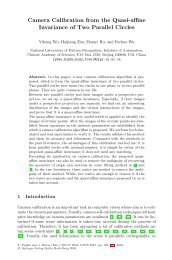
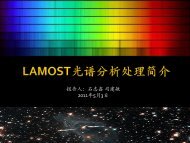
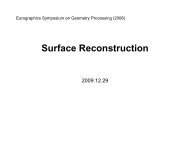
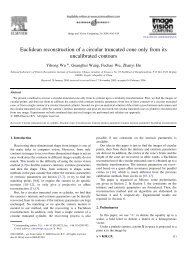
![Accurate, Dense, and Robust Multi-View Stereopsis (PMVS) [1,2,3]](https://img.yumpu.com/19388840/1/190x135/accurate-dense-and-robust-multi-view-stereopsis-pmvs-123.jpg?quality=85)


